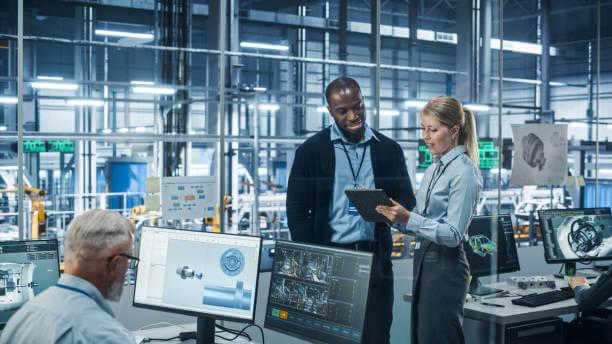In today's fast-paced industrial landscape, staying competitive is about efficiency and quality. Enter Computer Integrated Manufacturing (CIM), a game-changer that has revolutionized the manufacturing industry. In this article, we will delve deep into the world of CIM, exploring its applications, advantages, and what the future holds for this remarkable integration of computers into manufacturing processes. Simply put, Computer Integrated Manufacturing is a holistic approach employing computer systems to control production. Everything is automated and streamlined, from the design stage to the finished product. The integration of computer systems into manufacturing processes has led to a slew of benefits, ranging from efficiency gains to improved product quality. Below are some of the key ways CIM is transforming industries: CIM is more than just a technological breakthrough, it's a complete paradigm shift in business operations. Automating key processes in production offers a wide range of gains that improve output, quality, and efficiency. In the realm of Computer-Integrated Manufacturing (CIM), several key components work together to optimize the production process. Here are the key components that make up a CIM system: CIM begins with CAD, a technology that allows engineers and designers to create 2D and 3D digital representations of products. This virtual blueprint serves as the foundation for the entire manufacturing process, enabling precise design and customization. After finalizing the design, CAM comes into play. It converts the digital model into machine-readable instructions, which dictate how the manufacturing equipment will produce the physical product. CNC machines are an absolute requirement for carrying out the manufacturing strategy. These machines accurately cut, shape, and assemble materials with the help of instructions that are machine-readable from computer-aided manufacturing (CAM). As a last point of consideration, PLCs serve as the control centers of CIM systems. They closely monitor the production processes and make real-time adjustments to keep things running smoothly. By bringing together these four elements, CIM streamlines the production process from beginning to end, guaranteeing high levels of efficiency and accuracy from the design phase to final production. CIM is not limited to a single industry. It's like a Swiss Army knife that can be adapted for various purposes: Automotive Industry: In automobile manufacturing, CIM is essential as it facilitates the automation of detailed assembly processes, ensuring speed and precision. Aerospace: For the aerospace sector, CIM plays a vital role in producing top-notch, accurately-engineered components for both aircraft and spacecraft. Electronics: The electronics industry relies on CIM for the production of circuit boards and microchips, ensuring they are made with the utmost precision. Pharmaceuticals: CIM is employed in the pharmaceutical industry to help manufacturers adhere to strict quality standards for drug production. These examples showcase the diverse range of applications for CIM and demonstrate how this approach has been instrumental in significantly boosting levels of efficacy and reliability across a wide range of industries. Implementing Computer Integrated Manufacturing (CIM) brings about undeniable advantages, but addressing several challenges and considerations along the way is essential. Some of these challenges include: High Initial Investment - The upfront costs for software, hardware, and training can be substantial. Complex Integration - Synchronizing different systems, from design to production to inventory, requires seamless integration, which can be intricate. Training and Skill Acquisition - Employees must be trained in new technologies and methodologies, necessitating time and resources. Change Management - Shifting to CIM may meet resistance from employees accustomed to traditional manufacturing practices. Software Reliability - As operations depend on software, any malfunction can disrupt production. Data Management - Efficiently managing large amounts of data is vital, posing potential data storage, retrieval, and protection issues. Scalability Concerns - As the business grows, the CIM system must adapt without significant overhaul. Security Threats - With increased digital integration, there's a higher risk of cyber-attacks and data breaches. Vendor Dependence - Relying on specific technology providers can lead to upgrades, customizations, and support challenges. Maintenance Costs - Systems need updates, repairs, and replacements over time, leading to ongoing expenses. Despite these challenges, CIM has the potential to change manufacturing processes, delivering a combination of improved efficiency and growth if it is meticulously planned and strategically implemented. As technology continues its relentless march forward, Computer Integrated Manufacturing (CIM) is set to become an even more influential force in shaping the future of manufacturing. Here's what we can expect: CIM will incorporate artificial intelligence and machine learning to optimize processes further. Predictive maintenance, intelligent resource allocation, and adaptive production schedules will become the norm. The Internet of Things (IoT) will enable seamless connectivity between machines, sensors, and computers. This will lead to real-time data exchange, enhancing decision-making and overall efficiency. CIM will contribute to sustainability efforts by reducing waste and energy consumption. Manufacturers will adopt greener practices, aligning with the global shift towards eco-friendly production. Consumer demand for personalized products drives CIM to pivot towards mass customization. Manufacturers will adeptly produce customized items at scale, catering to individual preferences. As we peer into the future of CIM, it's clear that this technology will shape manufacturing and drive it toward a smarter, more sustainable, and highly customized era, meaning the possibilities are vast—the benefits for businesses and consumers alike are promising. At IOTEC, we're at the forefront of digital transformation in the manufacturing industry. Our cutting-edge solutions empower you to streamline operations, enhance efficiency, and boost productivity. Contact us today to explore how IOTEC can become your strategic partner in the digital world! To sum it up, Computer Integrated Manufacturing is transforming how industries operate. It's all about efficiency, cost reduction, and quality from design to production. Yes, there are challenges, but the benefits often outweigh the downsides. Computer Integrated Manufacturing (CIM) is a comprehensive product development and manufacturing approach. It integrates various functions—from design to production to inventory management—using specialized software solutions to facilitate each step. While robotics is commonly incorporated in CIM systems to boost automation and operational efficiency, it is not required. A CIM system can function effectively with or without robotics, depending on the specific needs and scale of the operation. Contrary to the perception that CIM is suitable only for large-scale manufacturing, small businesses can also reap the benefits of CIM. Small businesses can enhance efficiency and achieve cost reductions by deploying scaled-down versions tailored to their needs.
What is CIM?
How CIM Transforms Industries
Increased Efficiency
Improved Product Quality
Flexibility and Customization
Cost Savings
Data-Driven Decision Making
Real-time Monitoring
The Components of CIM
1. CAD (Computer-Aided Design)
2. CAM (Computer-Aided Manufacturing)
3. CNC (Computer Numerical Control)
4. PLC (Programmable Logic Controllers)

Real-World Applications of CIM
Challenges in Implementing CIM

The Future of CIM
AI and Machine Learning Integration
IoT Connectivity
Sustainability Focus
Customization on a Massive Scale
Revolutionize Your Manufacturing with IOTEC
Conclusion
FAQs
What does CIM encompass?
Is robotics a necessary component of CIM?
Can small businesses benefit from CIM?